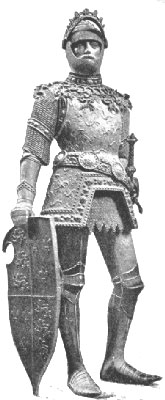1.1 England's legends!
After turning over several pages of Sonia's book, Paco reads about one of the best well-known England's legends, King Arthur's legend!

|
| Anonymous. Public Domain |
King Arthur is a legendary British leader who, according to medieval histories and romances, led the defence of Britain against the Saxon invaders in the early 6th century. The details of Arthur's story are mainly composed of folklore and literary invention, and his historical existence is debated and disputed by modern historians.Arthur's name occurs in early poetic sources.
The legendary Arthur developed as a figure of international interest largely through the popularity of Geoffrey of Monmouth's fanciful and imaginative 12th-century Historia Regum Britanniae (History of the Kings of Britain). However, some Welsh and Breton tales and poems relating the story of Arthur date from earlier than this work; in these works, Arthur appears either as a great warrior defending Britain from human and supernatural enemies or as a magical figure of folklore. How much of Geoffrey's Historia (completed in 1138) was adapted from such earlier sources, rather than invented by Geoffrey himself, is unknown.

|
| Anonymous. Public domain |
Geoffrey's version of events often served as the starting point for later stories. Geoffrey depicted Arthur as a king of Britain who defeated the Saxons and established an empire over Britain, Ireland, Iceland, Norway and Gaul. In fact, many elements and incidents that are now an integral part of the Arthurian story appear in Geoffrey's Historia, including Arthur's father Uther Pendragon, the wizard Merlin, the sword Excalibur, and Arthur's birth at Tintagel. The 12th-century French writer Chrétien de Troyes, who added Lancelot and the Holy Grail to the story, began the genre of Arthurian romance that became a significant strand of medieval literature. In these French stories, the narrative focus often shifts from King Arthur himself to other characters, such as various Knights of the Round Table.
Adapted from Wikipedia.org
All the Saxon Genitives previously mentioned are related to a person. However, there are some non-living things with which the Saxon Genitive is also used. Here you are some examples:
| Countries | England's legends / Scotland's top tourist attraction |
| Institutions / Organizations | The European Union's decisions / The Apostrophe Protection Society's website |
| Places + superlatives | Cáceres' greatest buildings / London's poorest districts |
| Time references | in four days'/weeks'/months'/years' time // tomorrow's match |
| Fixed expressions (idioms) | for goodness'/heaven's sake / a stone's throw |
| Well-known places (shops, stores, churches, cathedrals, friends' homes, etc.* | at the grocer's, St Patrick's, I met her at Paco's |
* As you can see, in those well-known places the second noun is frequently omitted.

|
| By Chris Dessaigne. C. Commons |
Verdadero Falso
Verdadero Falso
Verdadero Falso
Verdadero Falso